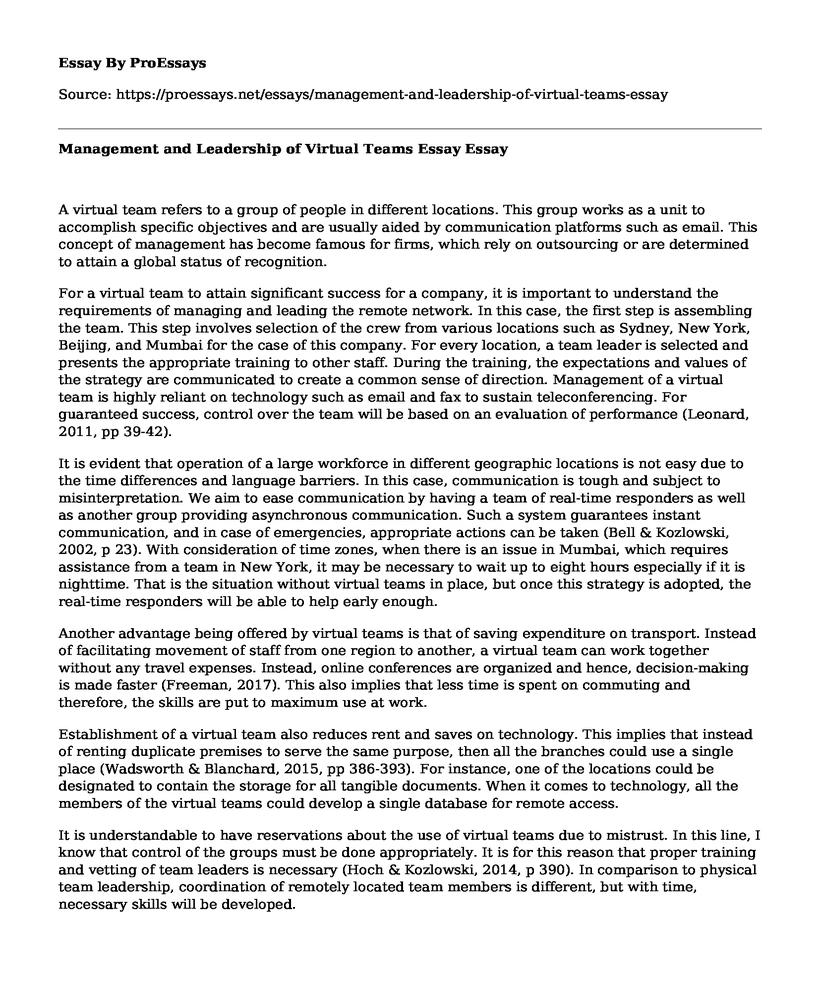A virtual team refers to a group of people in different locations. This group works as a unit to accomplish specific objectives and are usually aided by communication platforms such as email. This concept of management has become famous for firms, which rely on outsourcing or are determined to attain a global status of recognition.
For a virtual team to attain significant success for a company, it is important to understand the requirements of managing and leading the remote network. In this case, the first step is assembling the team. This step involves selection of the crew from various locations such as Sydney, New York, Beijing, and Mumbai for the case of this company. For every location, a team leader is selected and presents the appropriate training to other staff. During the training, the expectations and values of the strategy are communicated to create a common sense of direction. Management of a virtual team is highly reliant on technology such as email and fax to sustain teleconferencing. For guaranteed success, control over the team will be based on an evaluation of performance (Leonard, 2011, pp 39-42).
It is evident that operation of a large workforce in different geographic locations is not easy due to the time differences and language barriers. In this case, communication is tough and subject to misinterpretation. We aim to ease communication by having a team of real-time responders as well as another group providing asynchronous communication. Such a system guarantees instant communication, and in case of emergencies, appropriate actions can be taken (Bell & Kozlowski, 2002, p 23). With consideration of time zones, when there is an issue in Mumbai, which requires assistance from a team in New York, it may be necessary to wait up to eight hours especially if it is nighttime. That is the situation without virtual teams in place, but once this strategy is adopted, the real-time responders will be able to help early enough.
Another advantage being offered by virtual teams is that of saving expenditure on transport. Instead of facilitating movement of staff from one region to another, a virtual team can work together without any travel expenses. Instead, online conferences are organized and hence, decision-making is made faster (Freeman, 2017). This also implies that less time is spent on commuting and therefore, the skills are put to maximum use at work.
Establishment of a virtual team also reduces rent and saves on technology. This implies that instead of renting duplicate premises to serve the same purpose, then all the branches could use a single place (Wadsworth & Blanchard, 2015, pp 386-393). For instance, one of the locations could be designated to contain the storage for all tangible documents. When it comes to technology, all the members of the virtual teams could develop a single database for remote access.
It is understandable to have reservations about the use of virtual teams due to mistrust. In this line, I know that control of the groups must be done appropriately. It is for this reason that proper training and vetting of team leaders is necessary (Hoch & Kozlowski, 2014, p 390). In comparison to physical team leadership, coordination of remotely located team members is different, but with time, necessary skills will be developed.
Management and leadership of virtual teams are crucial in ensuring their success. It is needless to mention that this strategy saves a lot of time and money as well as ensures faster communication. In this case, the risks of conflict and mismanagement are lesser than the expected benefits, thus making virtual teams a viable project.
References
Bell, B.S. and Kozlowski, S.W., 2002. A typology of virtual teams: Implications for effective leadership. Group & Organization Management, 27(1), pp.14-49.
Freeman, C.M., 2017. Leadership Strategies to Create Success in Virtual Teams (Doctoral dissertation, Walden University).
Hoch, J.E. and Kozlowski, S.W., 2014. Leading virtual teams: Hierarchical leadership, structural supports, and shared team leadership. Journal of applied psychology, 99(3), p.390.
Leonard, B., 2011. Managing virtual teams. HR Magazine, 56(6), pp.39-42.
Wadsworth, M.B. and Blanchard, A.L., 2015. Influence tactics in virtual teams. Computers in Human Behavior, 44, pp.386-393.
Cite this page
Management and Leadership of Virtual Teams Essay. (2022, May 17). Retrieved from https://proessays.net/essays/management-and-leadership-of-virtual-teams-essay
If you are the original author of this essay and no longer wish to have it published on the ProEssays website, please click below to request its removal:
- Paper Example on Apple Innovation Strategy
- Knowledge Sharing in Decision-Making Essay
- Paper Example on Recreational/Skill Building Groups
- Paper Example on Operational and Supply Issues at Maudsley Hospital
- Labor Relations and Performance Management Essay
- Operational Analysis and Quality Improvement Paper Example
- Research Paper on Leadership in the Dynamic Healthcare System







